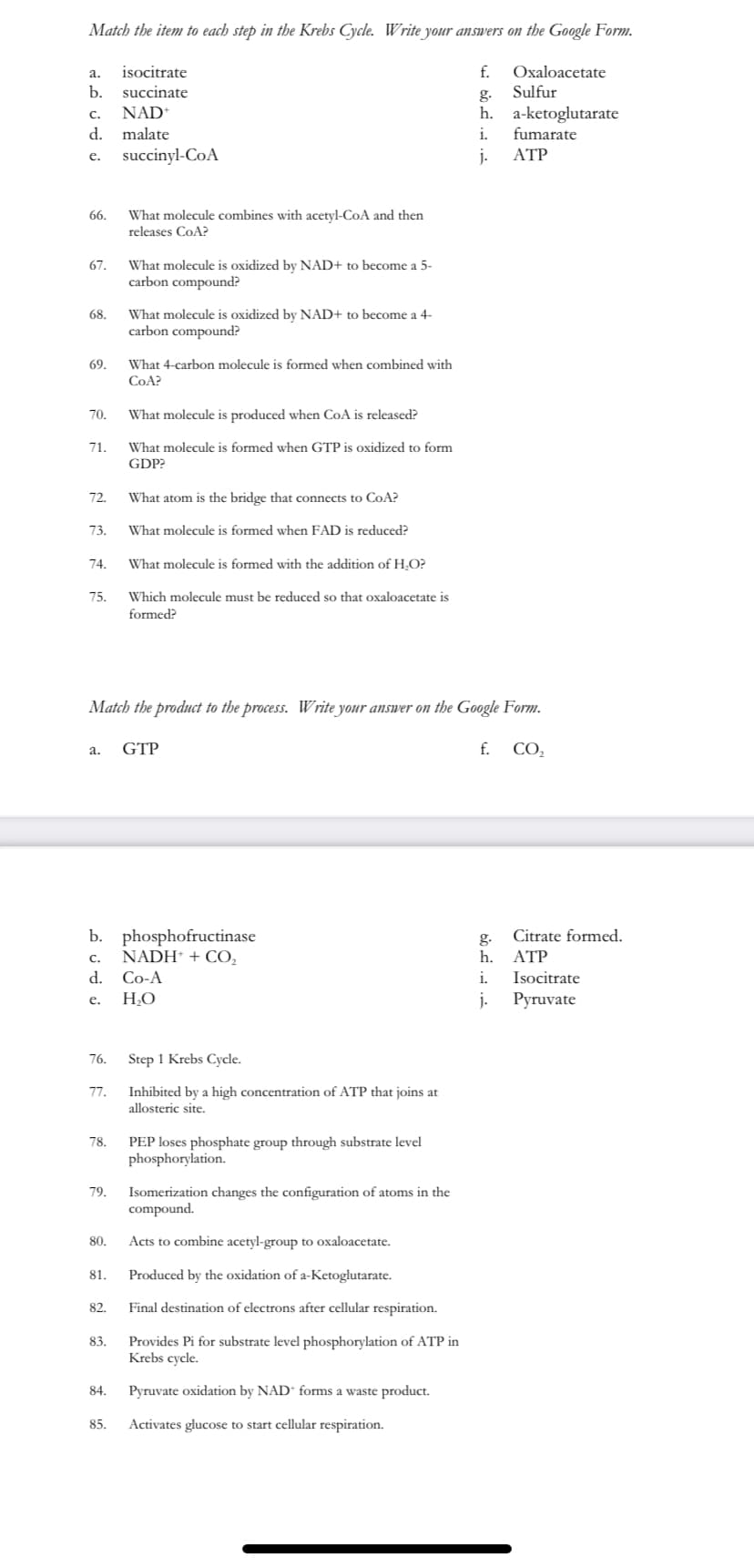Match the item to each step in the Krebs Cycle. Write your answers on the Google Form. a. isocitrate b. succinate f. Oxaloacetate Sulfur NAD d. malate e. succinyl-CoA g. h. a-ketoglutarate i. fumarate C. j. ATP 66. What molecule combines with acetyl-CoA and then releases CoA? What molecule is oxidized by NAD+ to become a 5- carbon compound? 67. What molecule is oxidized by NAD+ to become a 4- 68. carbon compound? 69. What 4-carbon molecule is formed when combined with CoA? 70. What molecule is produced when CoA is released? 71. What molecule is formed when GTP is oxidized to form GDP? 72. What atom is the bridge that connects to CoA? 73. What molecule is formed when FAD is reduced? 74. What molecule is formed with the addition of H,O? 75. Which molecule must be reduced so that oxaloacetate is formed?
Match the item to each step in the Krebs Cycle. Write your answers on the Google Form. a. isocitrate b. succinate f. Oxaloacetate Sulfur NAD d. malate e. succinyl-CoA g. h. a-ketoglutarate i. fumarate C. j. ATP 66. What molecule combines with acetyl-CoA and then releases CoA? What molecule is oxidized by NAD+ to become a 5- carbon compound? 67. What molecule is oxidized by NAD+ to become a 4- 68. carbon compound? 69. What 4-carbon molecule is formed when combined with CoA? 70. What molecule is produced when CoA is released? 71. What molecule is formed when GTP is oxidized to form GDP? 72. What atom is the bridge that connects to CoA? 73. What molecule is formed when FAD is reduced? 74. What molecule is formed with the addition of H,O? 75. Which molecule must be reduced so that oxaloacetate is formed?
Biochemistry
6th Edition
ISBN:9781305577206
Author:Reginald H. Garrett, Charles M. Grisham
Publisher:Reginald H. Garrett, Charles M. Grisham
Chapter19: The Tricarboxylic Acid Cycle
Section: Chapter Questions
Problem 22P: Study Figure 19.18 and decide which of the following statements is false. Pyruvate dehydrogenase is...
Related questions
Question

Transcribed Image Text:Match the item to each step in the Krebs Cycle. Write your answers on the Google Form.
isocitrate
f.
Oxaloacetate
a.
b.
succinate
g.
Sulfur
NAD*
h. a-ketoglutarate
fumarate
C.
d.
malate
i.
succinyl-CoA
j.
ATP
e.
What molecule combines with acetyl-CoA and then
releases CoA?
66.
What molecule is oxidized by NAD+ to become a 5-
carbon compound?
67.
What molecule is oxidized by NAD+ to become a 4-
carbon compound?
68.
69.
What 4-carbon molecule is formed when combined with
COA?
70.
What molecule is produced when CoA is released?
71.
What molecule is formed when GTP is oxidized to form
GDP?
72.
What atom is the bridge that connects to CoA?
73.
What molecule is formed when FAD is reduced?
74.
What molecule is formed with the addition of H,O?
75.
Which molecule must be reduced so that oxaloacetate is
formed?
Match the product to the process. Write your answer on the Google Form.
GTP
f. CO,
а.
b. phosphofructinase
NADH* + CO,
g.
Citrate formed.
c.
h.
ATP
d.
Co-A
i.
Isocitrate
HO
j-
Pyruvate
e.
76.
Step 1 Krebs Cycle.
Inhibited by a high concentration of ATP that joins at
allosteric site.
77.
PEP loses phosphate group through substrate level
phosphorylation.
78.
79.
Isomerization changes the configuration of atoms in the
compound.
80.
Acts to combine acetyl-group to oxaloacetate.
81.
Produced by the oxidation of a-Ketoglutarate.
82.
Final destination of electrons after cellular respiration.
Provides Pi for substrate level phosphorylation of ATP in
Krebs cycle.
83.
84.
Pyruvate oxidation by NAD“ forms a waste product.
85.
Activates glucose to start cellular respiration.
Expert Solution
This question has been solved!
Explore an expertly crafted, step-by-step solution for a thorough understanding of key concepts.
This is a popular solution!
Trending now
This is a popular solution!
Step by step
Solved in 2 steps with 5 images

Recommended textbooks for you

Biochemistry
Biochemistry
ISBN:
9781305577206
Author:
Reginald H. Garrett, Charles M. Grisham
Publisher:
Cengage Learning

Biochemistry
Biochemistry
ISBN:
9781305577206
Author:
Reginald H. Garrett, Charles M. Grisham
Publisher:
Cengage Learning